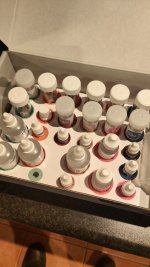Yes , you can test for CC with FC zero.
Yes, the CCL pH-test maxes out at 7.8, which is a bit annoying. I actually got a Taylor comparator block now for that reason, but mostly use a pH-meter. For dosage, you enter 7.8 as current into
PoolMath and then calculate dosage required to lower to 7.6. Run pump for 30 min after adding acid, then retest pH and repeat if required.
For TA I would use the test with a 25ml sample to get 10ppm per drop resolution. You want TA a bit more precise, as it is important to get the acid dosage right, and to get a reasonable CSI value (EDIT: low CSI is not an issue for you, but you don't want CSI too high to avoid scaling, and with a SWG you want a slightly negative CSI to keep the cell clean).
For CH, the test with a 10ml sample and 25ppm resolution per drop is sufficient. I think with a fibreglass pool, that CH should be fine. I wouldn't worry about it now and see how it develops over time. Depending on rain amounts it can rise or drop over time. My CH drops over winter and only slightly rises over summer with fill water replacing evaporation, so that I have to add calcium chloride from time to time. Maybe bring it up to the lower end of the manufacturer's range.
Have you added CYA yet? You want some in the water to have your FC moderated, otherwise you'll have astronomical HOCl each time you add chlorine, but then it burns off in no time. You don't need much over winter, but I'd recommend some
Regarding the manufacturer's levels - they only seem to be "suggested", so there is no implication that warranty requires following them?
The differentiation between FC targets when stabilised vs. unstabilised chlorine is BS. Important is the current level of stabiliser already in the pool, not whether you add a bit of stabiliser with your chlorine. But continued use of stabilised chlorine lets the stabiliser level creep up, requiring ever higher FC following TFP's recommended
FC/CYA Levels. I find the recommended FC range a bit too low.
With stabiliser, pH up to 7.8 - even 8 - is OK, and will result in slower pH-rise. The CYA-FC equilibrium chemistry flattens the HOCl's pH despondency, up to 8 or 8.2 is definitely covered by the recommended
FC/CYA Levels in regards to sufficient sanitising power.
I'd recommend to stick to the lower TA range. Try to avoid raising TA before hitting TA 50, otherwise you'll just get into a baking soda / acid seesaw. My TA is quite stable in the range 70-90 ppm, I never add Alkalinity increaser (baking soda). I still have a bag from the old days that my wife uses in the garden now.
TDS<1500 is chemically impossible with a SWG, salt is the main constituent of TDS. TDS is meaningless, it's just a sum of everything that's in a pool. If TDS is high because of rocket high CYA, then this is a problem. But to identify this, you test directly for CYA. Important is that your individual water parameters are in range, TDS is pointless. Historically, it used to be an easy to measure indicator in pools that were exclusively chlorinated with trichlor tabs. Once TDS got that high (caused by added chlorine turning into salt and the CYA that comes with the trichlor) it was an indicator that the pool was over-stabilised by then and time for a water exchange to get rid of the CYA.
Follow the salt levels that your SWG is specified for.
Don't obsess over phosphates. But that is something that some manufacturers (especially for SWGs) fuss about the most when it gets to warranty claims, and it won't hurt to follow their advice, as long as you do it based on your own testing (I use the LaMotte Insta test about 1-2 times a year, they are strips that add a reagent to the water and then you compare the water colour with a chart).






